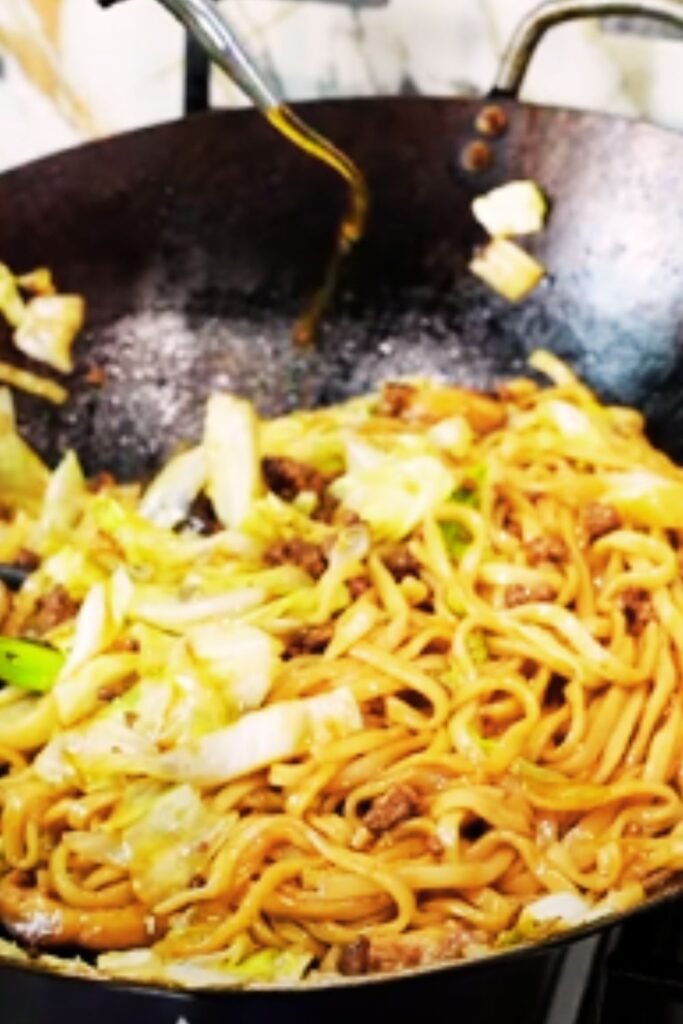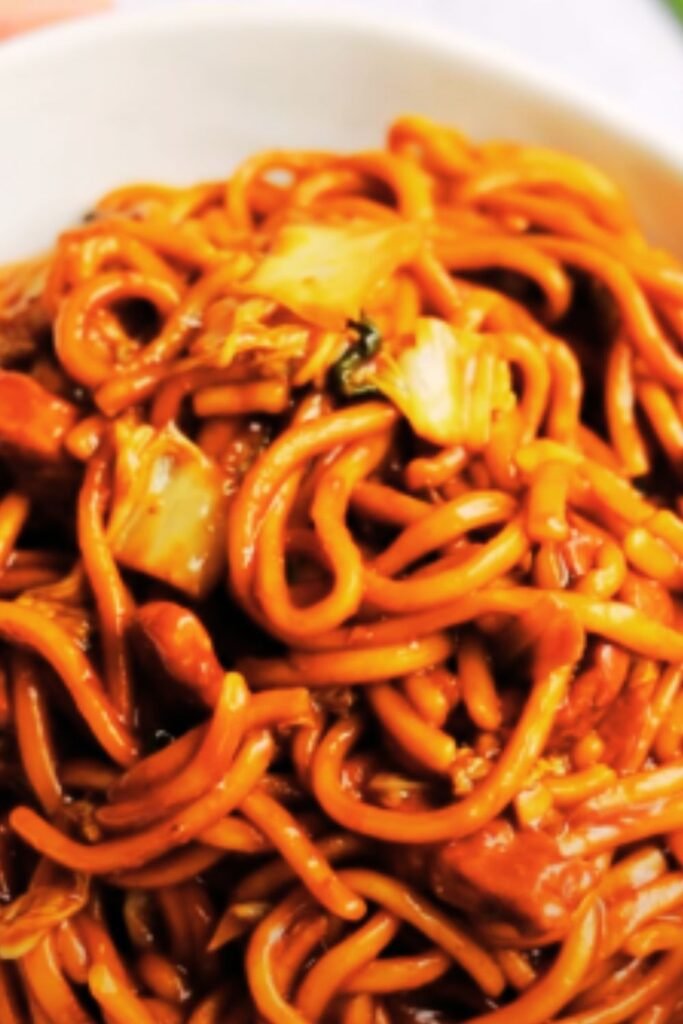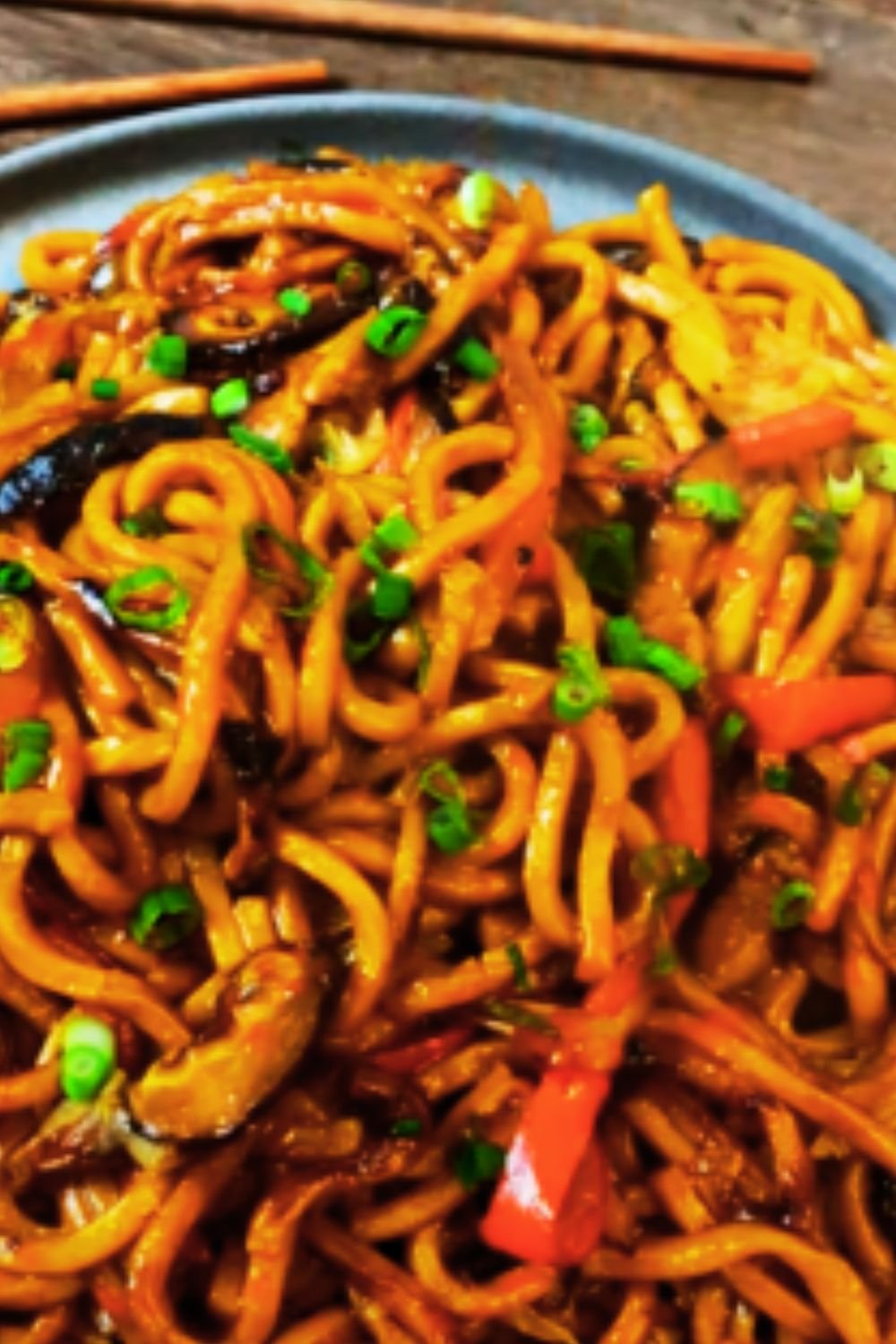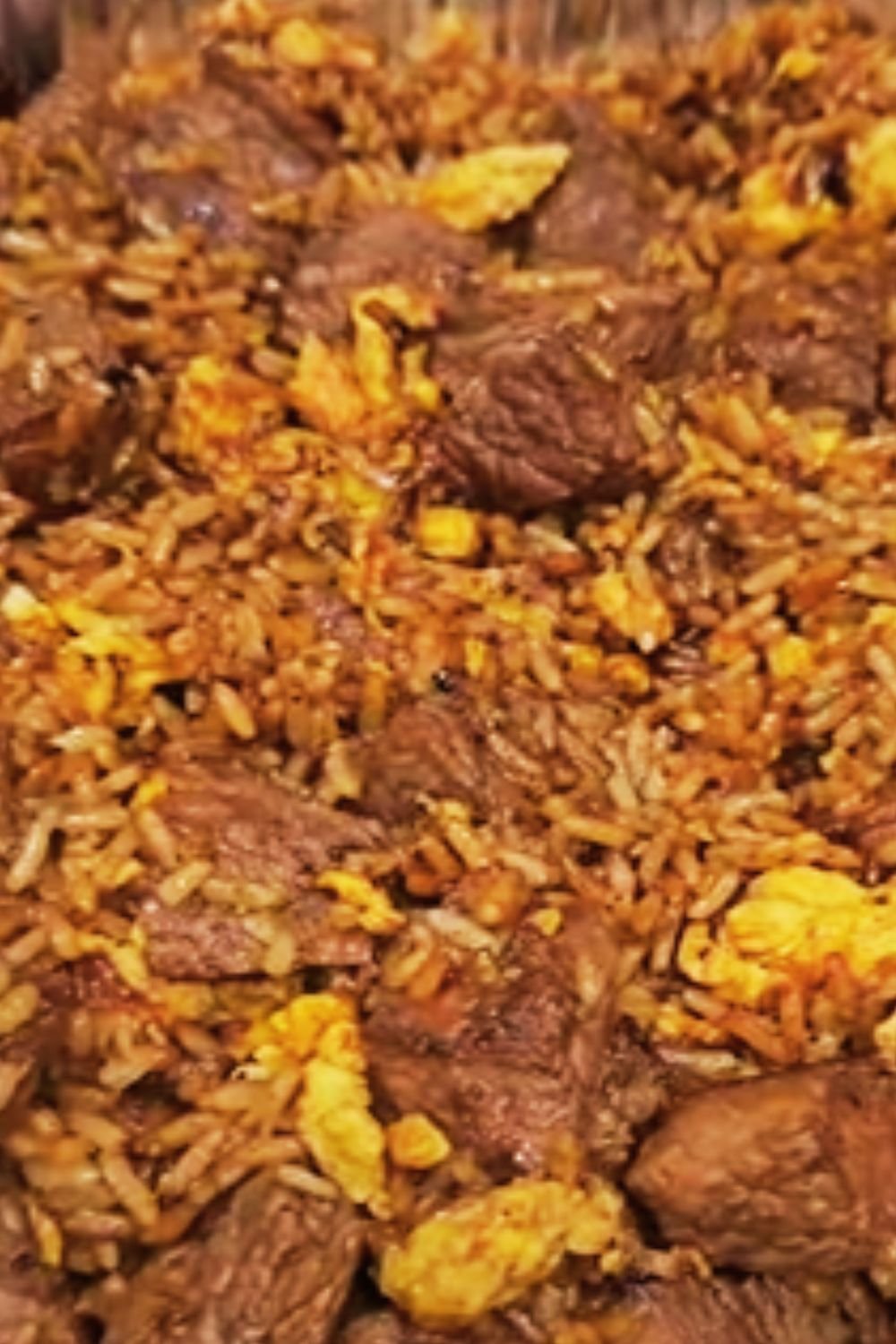Shanghai Fried Noodles, also known as “Cu Chao Mian,” is one of my absolute favorite Chinese noodle dishes. The thick, chewy noodles coated in a rich, savory sauce alongside tender vegetables and protein create a perfect harmony of flavors and textures. Today, I’m excited to share my authentic recipe that will bring the taste of Shanghai street food right to your kitchen!
What Makes Shanghai Fried Noodles Special?
What sets Shanghai fried noodles apart from other Chinese noodle dishes is the distinctive thick, chewy noodles (typically made from wheat flour) and the deep, caramelized sauce. The noodles develop a beautiful smoky flavor from being stir-fried at high heat in a wok. This dish carries a perfect balance of sweet and savory elements that make it utterly irresistible.
I first tasted authentic Shanghai fried noodles during a culinary tour of China’s eastern regions. The combination of those thick, chewy noodles with the rich umami sauce left such an impression that I’ve spent years perfecting my own version. Now, I’m thrilled to share this recipe that brings those same authentic flavors to your home cooking.
The History Behind the Dish
Shanghai fried noodles originated in (you guessed it!) Shanghai, one of China’s largest and most cosmopolitan cities. This dish emerged as a popular street food during the early 20th century when Shanghai was developing as a major trading port. The noodles reflect the city’s culinary style, which tends to favor slightly sweeter flavors compared to other Chinese regional cuisines.
In traditional Shanghai homes, this dish was often prepared using leftover ingredients, making it a practical yet delicious way to create a satisfying meal. Today, it remains a beloved comfort food throughout China and has gained popularity worldwide for its robust flavors and satisfying texture.
Key Ingredients for Perfect Shanghai Fried Noodles
Before we dive into the cooking process, let’s take a closer look at the essential ingredients that give Shanghai fried noodles their distinctive character:
| Ingredient | Description | Purpose in the Dish |
|---|---|---|
| Thick wheat noodles | Fresh or dried udon-style noodles with a chewy texture | Forms the base of the dish and provides the characteristic chewiness |
| Dark soy sauce | Thicker and less salty than regular soy sauce with a caramel-like sweetness | Provides the deep brown color and rich flavor |
| Light soy sauce | Thinner and saltier than dark soy sauce | Adds savory umami flavor without darkening the dish too much |
| Shaoxing wine | Chinese rice wine with a distinctive fragrance | Adds depth and removes any potential “gaminess” from proteins |
| Sugar | Granulated white sugar | Balances the saltiness and enhances caramelization |
| Pork | Thinly sliced pork loin or shoulder | Traditional protein choice that remains tender when quickly stir-fried |
| Bok choy | Chinese leafy green vegetable | Adds freshness, color, and nutritional value |
| Shiitake mushrooms | Umami-rich fungi | Contributes earthy flavor and meaty texture |
| Green onions | Fresh scallions | Provides aromatic finish and color contrast |
| Garlic and ginger | Fresh aromatics | Forms the flavor foundation for the stir-fry |

Shanghai Fried Noodles Recipe
Prep Time: 20 minutes
Cook Time: 15 minutes
Total Time: 35 minutes
Servings: 4
Ingredients
For the sauce:
- 3 tablespoons dark soy sauce
- 2 tablespoons light soy sauce
- 1 tablespoon Shaoxing wine (or dry sherry)
- 2 teaspoons sugar
- 1 teaspoon sesame oil
- ¼ teaspoon white pepper
For the noodles:
- 1 pound (450g) thick wheat noodles (udon or Shanghai-style noodles)
- 3 tablespoons vegetable oil, divided
- 3 cloves garlic, minced
- 1 tablespoon fresh ginger, grated
- 8 ounces (225g) pork loin, thinly sliced
- 8 ounces (225g) bok choy, chopped into 2-inch pieces
- 6 ounces (170g) shiitake mushrooms, stems removed and sliced
- 1 medium carrot, julienned
- 4 green onions, cut into 2-inch segments
- 1 teaspoon cornstarch mixed with 2 tablespoons water (optional, for thicker sauce)
- Sesame seeds for garnish (optional)
Instructions
- Prepare the noodles: Cook the noodles according to package instructions, but reduce the cooking time by about 1 minute (they should be slightly undercooked). Drain and rinse under cold water to stop the cooking process. Toss with 1 teaspoon of vegetable oil to prevent sticking and set aside.
- Make the sauce: In a small bowl, combine dark soy sauce, light soy sauce, Shaoxing wine, sugar, sesame oil, and white pepper. Stir until sugar is dissolved and set aside.
- Prepare the protein: In a medium bowl, marinate the sliced pork with 1 tablespoon of the sauce mixture for at least 10 minutes.
- Heat the wok: Place a wok or large skillet over high heat until it’s smoking hot. Add 1 tablespoon of vegetable oil and swirl to coat.
- Cook the protein: Add the marinated pork to the wok, spreading it out in a single layer. Let it sear for 30 seconds without stirring, then stir-fry for another 1-2 minutes until mostly cooked through. Remove the pork from the wok and set aside.
- Stir-fry aromatics and vegetables: Add another tablespoon of oil to the wok. Add garlic and ginger, stir-frying for 30 seconds until fragrant. Add shiitake mushrooms and stir-fry for 1-2 minutes. Add carrots and the white parts of bok choy, cooking for another 2 minutes. Finally, add the leafy parts of bok choy and half of the green onions, cooking until the bok choy just begins to wilt.
- Combine everything: Add the remaining tablespoon of oil and the cooked noodles to the wok. Pour the sauce over the noodles and toss everything together, ensuring the noodles are evenly coated. Return the cooked pork to the wok and continue stir-frying for 2-3 minutes, allowing the noodles to caramelize slightly on the bottom of the wok before tossing again.
- Finish the dish: If the sauce seems too thin, add the cornstarch slurry and toss for another 30 seconds until thickened. Add the remaining green onions and toss to combine.
- Serve: Transfer to serving plates and garnish with sesame seeds if desired.

Pro Tips for Perfect Shanghai Fried Noodles
After making this dish countless times, I’ve discovered several techniques that elevate homemade Shanghai fried noodles to restaurant quality:
- Use the right noodles: Thick, wheat-based noodles create the authentic texture. If you can’t find Shanghai-style noodles, udon noodles make an excellent substitute.
- Undercook the noodles slightly: Since they’ll continue cooking in the wok, stopping just short of fully cooked prevents them from becoming mushy.
- Prep everything before starting: Stir-frying happens quickly, so having all ingredients prepped and easily accessible (mise en place) ensures smooth cooking.
- Use a very hot wok: The characteristic “wok hei” (breath of the wok) flavor comes from cooking at high temperatures. Your wok should be smoking hot before adding oil.
- Cook in batches if needed: If your wok isn’t large enough, cook ingredients in batches to maintain high heat. Overcrowding the wok reduces temperature and leads to steaming rather than proper stir-frying.
- Don’t skimp on dark soy sauce: It provides both color and flavor. The dish should have a rich, caramelized appearance when finished.
- Let the noodles caramelize: Allow the noodles to sit undisturbed against the hot wok for short intervals to develop those delicious crispy bits.
Variations to Try
One of the beauties of Shanghai fried noodles is how versatile the recipe can be. Here are some delicious variations to try:
Protein Options:
- Chicken: Substitute thinly sliced chicken breast or thighs for the pork
- Beef: Thinly sliced flank steak works beautifully
- Shrimp: Peeled and deveined shrimp cook even faster than pork
- Tofu: For a vegetarian version, use firm tofu cut into thin slices and pan-fried until golden
Vegetable Options:
- Napa cabbage: Adds sweetness and retains some crunch
- Bean sprouts: Contribute a fresh crunch that contrasts with the chewy noodles
- Bell peppers: Add vibrant color and sweet flavor
- Chinese broccoli (gai lan): Brings a pleasant bitterness that balances the sweet sauce
Sauce Variations:
- Spicy version: Add 1-2 teaspoons of chili oil or chili crisp
- Extra savory: Add 1 teaspoon of oyster sauce
- Sweeter profile: Increase sugar to 1 tablespoon
- Tangier twist: Add 1 teaspoon of black vinegar
Common Mistakes to Avoid
In my years of making this dish, I’ve encountered (and made!) several common pitfalls. Here’s how to avoid them:
| Mistake | Why It Happens | How to Avoid It |
|---|---|---|
| Mushy noodles | Overcooking before stir-frying | Undercook noodles by 1 minute and rinse with cold water |
| Sticky, clumped noodles | Not adding oil after cooking | Toss drained noodles with a bit of oil |
| Bland flavor | Not enough sauce | Don’t be shy with the sauce ingredients |
| Sauce too watery | Too much moisture from vegetables | Cook vegetables properly to release water before adding noodles |
| Burnt rather than caramelized | Heat too high or cooking too long | Monitor closely and adjust heat as needed |
| Uneven flavor distribution | Poor tossing technique | Use chopsticks and a spatula together for better control |
Serving Suggestions
Shanghai fried noodles can be enjoyed as a complete meal on their own, but here are some suggestions for rounding out your dining experience:
- Side dishes: Simple cucumber salad dressed with rice vinegar, sesame oil, and a touch of sugar; steamed dumplings; or a light soup like egg drop or hot and sour
- Beverages: Jasmine tea, oolong tea, or chrysanthemum tea complement the rich flavors wonderfully
- Dessert: End your meal with something light and refreshing like fresh fruit, especially sliced oranges or Asian pears

Storing and Reheating Leftovers
Shanghai fried noodles actually taste amazing the next day as the flavors have time to meld even further. Here’s how to properly store and reheat them:
- Storage: Transfer cooled leftovers to an airtight container and refrigerate for up to 3 days.
- Reheating: The best way to reheat these noodles is in a wok or skillet over medium-high heat with a tablespoon of water to help loosen them up. Stir frequently until heated through, about 3-5 minutes. You can also microwave them, but the texture won’t be quite as good.
- Freezing: I don’t recommend freezing these noodles as the texture suffers significantly upon thawing.
Frequently Asked Questions
Q: Can I make Shanghai fried noodles ahead of time? A: While best enjoyed fresh, you can prepare all the components ahead of time. Cook and store the noodles (tossed with a bit of oil), prepare the sauce, and slice all vegetables and protein. Store everything separately in the refrigerator, then stir-fry just before serving.
Q: Where can I find authentic Shanghai-style noodles? A: Look for thick wheat noodles labeled as “Shanghai noodles,” “udon,” or “lo mein” at Asian grocery stores. In a pinch, linguine pasta can substitute, though the texture will be different.
Q: Is there a gluten-free version? A: Yes! Use rice noodles (the wider variety works best) and substitute tamari for soy sauce. The texture will be different but still delicious.
Q: How can I make these noodles less salty? A: Reduce the amount of light soy sauce and increase the dark soy sauce slightly (which has a more complex flavor but less salt). You can also add a bit more Shaoxing wine and sugar to balance the flavors.
Q: Why are my noodles always sticking together? A: Make sure to rinse the cooked noodles under cold water and toss them with a bit of oil before setting aside. Also, ensure your wok is hot enough before adding the noodles, and keep them moving with chopsticks or a spatula.
Q: Can I make a vegetarian version? A: Absolutely! Omit the meat and increase the mushrooms, or add firm tofu that’s been pressed and pre-fried. You can also add more vegetables like bell peppers, snow peas, or broccoli for extra nutrition and flavor.
Q: What’s the difference between Shanghai noodles and lo mein? A: Shanghai noodles specifically refer to the thicker wheat noodles used in this dish, while lo mein is a more general term for stir-fried noodles. Shanghai fried noodles typically have a darker sauce and chewier texture than typical lo mein.
Final Thoughts
Shanghai fried noodles exemplify the beauty of Chinese cuisine – simple ingredients transformed through precise technique into something greater than the sum of its parts. What I love most about this dish is how it balances flavors and textures: the chewy noodles, tender meat, crisp vegetables, and that deeply savory sauce with its subtle sweetness.
Don’t be discouraged if your first attempt isn’t perfect. Like all great dishes, Shanghai fried noodles improve with practice as you develop a feel for the right heat, timing, and proportions. Soon enough, you’ll be creating this classic comfort food with the confidence of a seasoned chef.
I hope this recipe brings as much joy to your table as it has to mine. There’s something incredibly satisfying about mastering a dish that connects us to culinary traditions from across the world. Happy cooking!


